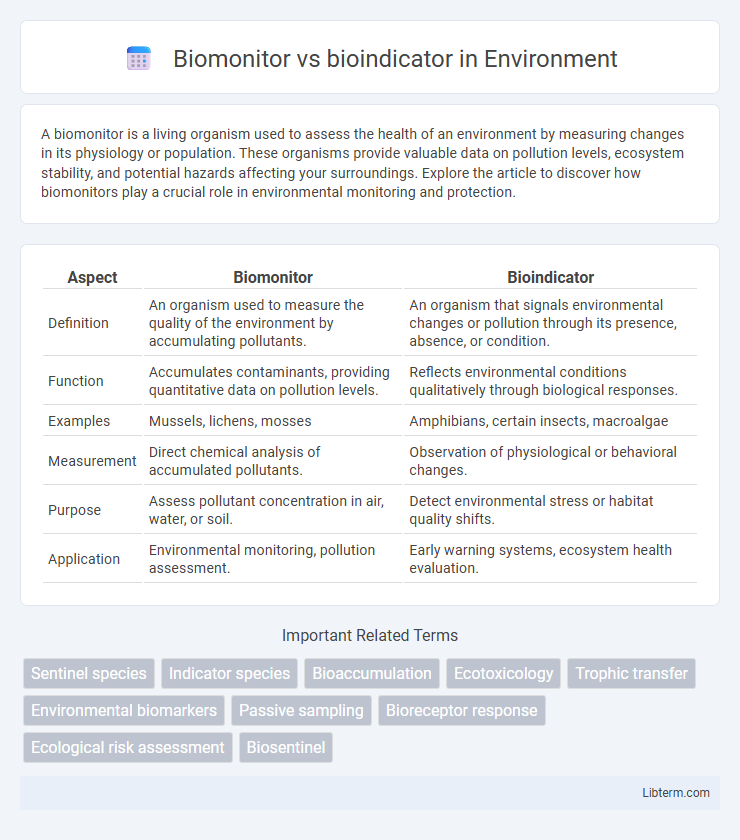A biomonitor is a living organism used to assess the health of an environment by measuring changes in its physiology or population. These organisms provide valuable data on pollution levels, ecosystem stability, and potential hazards affecting your surroundings. Explore the article to discover how biomonitors play a crucial role in environmental monitoring and protection.
Table of Comparison
| Aspect | Biomonitor | Bioindicator |
|---|---|---|
| Definition | An organism used to measure the quality of the environment by accumulating pollutants. | An organism that signals environmental changes or pollution through its presence, absence, or condition. |
| Function | Accumulates contaminants, providing quantitative data on pollution levels. | Reflects environmental conditions qualitatively through biological responses. |
| Examples | Mussels, lichens, mosses | Amphibians, certain insects, macroalgae |
| Measurement | Direct chemical analysis of accumulated pollutants. | Observation of physiological or behavioral changes. |
| Purpose | Assess pollutant concentration in air, water, or soil. | Detect environmental stress or habitat quality shifts. |
| Application | Environmental monitoring, pollution assessment. | Early warning systems, ecosystem health evaluation. |
Introduction to Biomonitor and Bioindicator
Biomonitor refers to organisms or biological systems used to assess environmental quality by measuring specific biological responses to pollutants or stressors. Bioindicator is a broader term encompassing any species or biological parameter that signals the condition of an ecosystem or presence of contaminants. Both biomonitors and bioindicators serve as vital tools in ecological monitoring, with biomonitors providing quantitative data on pollutant accumulation and bioindicators offering qualitative insights into ecosystem health.
Definitions: Biomonitor vs Bioindicator
A biomonitor is a living organism used to assess the quality of the environment by accumulating contaminants, providing direct evidence of pollution levels. A bioindicator refers to any species or biological response that reveals the presence or intensity of environmental changes, often signaling ecosystem health. Both terms are essential in ecological monitoring, with biomonitors actively accumulating pollutants and bioindicators broadly indicating environmental conditions.
Key Differences Between Biomointors and Bioindicators
Biomonitors are living organisms used to measure quantitative levels of specific environmental contaminants, such as heavy metals or air pollutants, providing precise data on pollutant accumulation over time. Bioindicators, on the other hand, are species or biological responses used qualitatively to signal overall ecosystem health or the presence of environmental stressors, often through observable changes like altered behavior or physiology. The key difference lies in biomonitors offering measurable contaminant concentrations, while bioindicators indicate general environmental conditions or ecological impacts without precise quantification.
Mechanisms of Action: How They Work
Biomonitor organisms accumulate pollutants through physiological processes such as bioaccumulation, reflecting environmental contamination levels over time. Bioindicators exhibit measurable responses like changes in behavior, physiology, or population dynamics triggered by specific environmental stressors. Both mechanisms provide critical insights into ecosystem health, with biomonitors offering quantitative data on pollutant concentrations while bioindicators reveal qualitative effects and early signs of ecological disturbance.
Examples of Biomonitor Organisms
Biomonitors are organisms used to assess environmental conditions by accumulating contaminants, with examples including mosses for air pollution and bivalves like mussels for monitoring water quality. Bioindicator organisms signal the health of an ecosystem based on their presence, absence, or condition, such as amphibians indicating freshwater ecosystem health. Key biomonitor species like lichens, snails, and certain algae provide measurable data on heavy metals and chemical pollutants in soil, water, and air.
Examples of Bioindicator Species
Bioindicator species are organisms used to assess the health of an environment by signaling changes in ecosystem conditions through their presence, absence, or condition. Examples of bioindicator species include lichens, which reveal air pollution levels; amphibians, such as frogs, that indicate water quality; and benthic macroinvertebrates, which reflect sediment and water quality in freshwater systems. These bioindicators provide critical data for environmental monitoring and help detect ecological disturbances early.
Applications in Environmental Monitoring
Biomonitoring employs living organisms to assess environmental conditions, measuring responses such as physiological or biochemical changes, while bioindicators are specific species or biological responses that signal the presence of pollutants or ecosystem health. Both tools are essential in monitoring air and water quality, detecting heavy metals, pesticides, and organic pollutants. Their applications include tracking ecosystem changes, early detection of contamination, and informing environmental policies for sustainable management.
Advantages and Limitations of Biomonitoring
Biomonitoring offers precise, real-time data on environmental pollutants by analyzing living organisms, providing a direct reflection of ecosystem health and pollutant bioaccumulation. Its advantages include the ability to detect early biological effects of contaminants and integrate complex environmental interactions over time. Limitations involve variability due to species-specific responses, potential confounding factors like seasonal changes, and challenges in standardizing biomonitoring protocols across different ecosystems.
Advantages and Limitations of Bioindication
Bioindicators offer a cost-effective and accessible method to monitor environmental health by reflecting changes in ecosystem conditions through biological responses. However, bioindication faces limitations such as sensitivity to multiple stressors, which can complicate the interpretation of results, and the need for species-specific knowledge to accurately assess environmental quality. Despite these challenges, bioindicators provide valuable early-warning signs of pollution and habitat degradation that are essential for timely ecosystem management.
Future Perspectives and Emerging Trends
Future perspectives in biomonitor and bioindicator research emphasize integrating advanced genomic and proteomic technologies to enhance species-specific sensitivity and accuracy. Emerging trends include deploying AI-driven data analytics and remote sensing for real-time environmental monitoring and predictive modeling. These innovations aim to improve ecological risk assessments and support adaptive ecosystem management strategies.
Biomonitor Infographic

 libterm.com
libterm.com